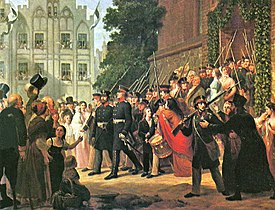Gustav Graef


Gustav Graef (14 December 1821 – 6 January 1895) was a German painter, primarily of portraits and historical subjects.
Life and work[edit]
Graef was born in Königsberg. In 1842, he entered the University of Königsberg, where he was an enthusiastic member of the Student Corps and produced his first lithographs.[1] His training as a painter began in Düsseldorf with Theodor Hildebrandt and Wilhelm von Schadow at the Royal Academy. He made several study trips to Antwerp, Paris, Munich and Italy.[2]
Upon his return to Königsberg, he married a former acquaintance from his drawing class, the painter and lithographer Franziska Liebreich (1824–1893), who came from a prominent Jewish family.[3] One of their sons, Botho, became a noted art historian. Their daughter Sabine married the painter Reinhold Lepsius and became a well-known painter herself.
In 1849, he received the contract to paint frescoes in the south dome hall of the Neues Museum; designed by Wilhelm von Kaulbach, depicting Widukind's reconciliation with Charlemagne. This necessitated a move to Berlin and was followed by a commission to paint four scenes from the Labors of Hercules for the Altes Museum. After 1862, he focused on idealized female portraits, which brought him great commercial success. He became a member of the Prussian Academy of the Arts in 1880.[citation needed]
At the peak of his fame, in 1885, he was arrested and charged with the abuse of an underage model. This became a major scandal in Berlin society, as the young woman in question was from a notable family that had been very hospitable to Graef. He was eventually acquitted, but not without great damage to all the parties involved.[4][5] He died in Berlin, aged 73.
References[edit]
- ^ Kösener Korps-Listen, 1910, 142, 74
- ^ Hermann A. Müller: Biographisches Künstler-Lexikon, Bibliographischen Instituts, Leipzig, 1882
- ^ Petra Wilhelmy-Dollinger: Die Berliner Salons: Mit historisch-literarischen Spaziergängen, Walter de Gruyter, 2000 ISBN 978-3-11-016414-5
- ^ Annette Dorgerloh: Das Künstlerehepaar Lepsius - Zur Berliner Porträtmalerei um 1900. Akademie Verlag, Berlin 2003, ISBN 3-05-003722-9]
- ^ Paul Lindau: Der Prozeß Graef. Drei Berliner Sensationsprozesse sowie zwei andere aufsehenerregende Kriminalfälle des ausgehenden 19. Jahrhunderts. Berlin (DDR) 1985
External links[edit]
![]() Media related to Gustav Graef at Wikimedia Commons
Media related to Gustav Graef at Wikimedia Commons
